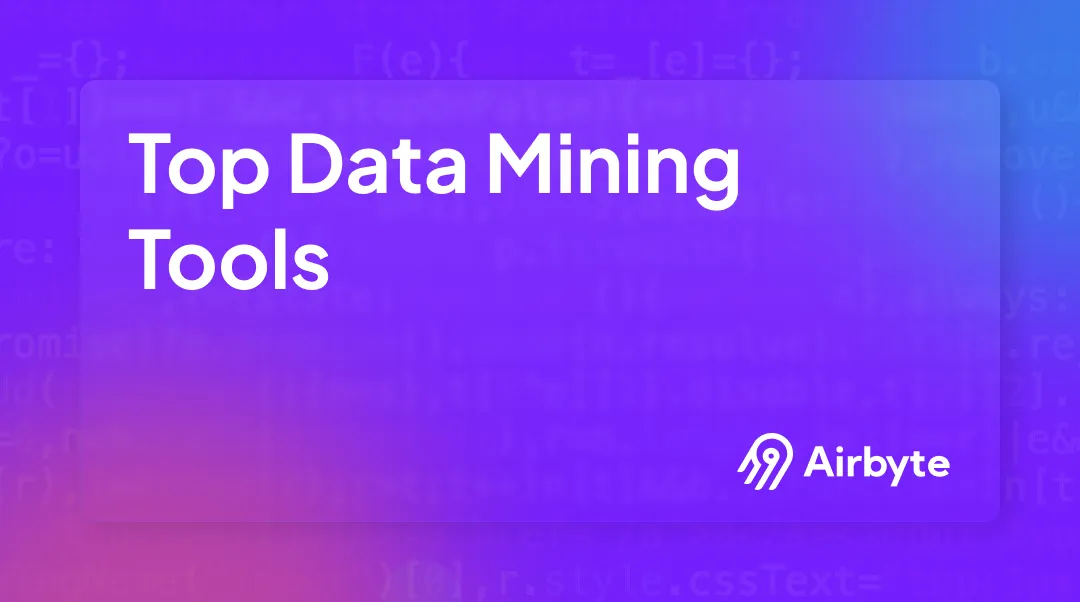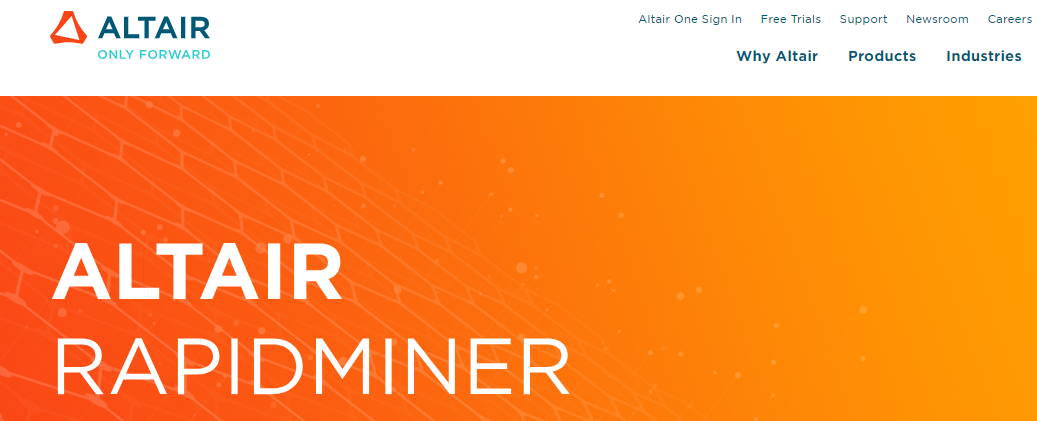Top 5 Data Mining Tools for Business Success in 2026
Summarize this article with:


Data mining plays a crucial role in supporting business intelligence and data analytics. Its importance has grown significantly across various industries, leading to the emergence of new tools and software advancements. Consequently, selecting the right data mining tool has become a challenging and time-consuming process. This article will provide an overview of data mining and highlight the top data mining tools, along with their significant features.
What is Data Mining
Data mining is the process of extracting valuable information from large sets of data. This involves identifying patterns, trends, and insights that can help you better understand your business. It uses various techniques, such as statistical analysis and machine learning, to obtain potentially useful information from raw data. However, analyzing huge volumes of data can be a complex process, which is where data mining tools come in. These tools streamline the data mining process, making it easier to process extensive datasets.
Types of Data Mining Models
Data mining involves advanced techniques to create models that reveal patterns and correlations in data. The two primary types of models used in data mining are descriptive and predictive.
Descriptive Models: Descriptive models aim to summarize and describe the characteristics and patterns present in the data. These models don't predict future outcomes but focus on analyzing historical data. Descriptive models are useful for exploring data, identifying trends, patterns, and relationships, and gaining insights into the underlying structure of the data.
Predictive Models: One of the primary purposes of predictive models is to provide estimates or predictions about future events. To achieve this, these models leverage advanced machine learning algorithms. They analyze past data, identify patterns and trends, and offer data-driven insights on the probability of a future outcome. For instance, a predictive model can help approximate future sales of a product by taking into account past sales data.
Top 5 Data Mining Tools
Here are some popular data mining tools that you can consider in 2025:
Orange

Orange is an open-source data mining tool that offers a visual programming interface for data analysis. It allows you to construct workflows by connecting pre-built components called widgets. These widgets represent various algorithms and techniques for tasks such as data retrieval, preprocessing, clustering, etc. This makes building complex data analytics pipelines easier without extensive programming knowledge.
Here is an overview of the key features:
- Orange supports popular file formats such as Excel (.xlsx), comma-separated values (.csv), and tab-delimited files (.txt). It also can read data from online sources, including Google Spreadsheets.
- The Scoring Sheet widget explains how a machine learning model makes predictions by assigning scores to different factors. This allows you to gain insights into which features significantly impact the model's predictions.
- Orange is compatible with multiple operating systems, including macOS, Windows, and Linux. Furthermore, it can be easily installed from the Python Package Index (PyPI) repository.
Apache Mahout

Apache Mahout is an open-source project for developing scalable machine-learning algorithms. It primarily operates within the Hadoop ecosystem, utilizing the MapReduce paradigm to efficiently process extensive datasets. This tool is particularly recommended for tackling complex and large-scale data mining problems. Its native support for distributed backends, such as Apache Spark, facilitates faster processing speeds and improved performance.
Here is an overview of the key features:
- Mahout incorporates a specialized linear algebra framework called Samsara that serves as a base for its various machine-learning algorithms. This framework guarantees precise mathematical calculations and high computational efficiency.
- It provides various clustering algorithms, including K-means and canopy clustering, for grouping similar data points.
- Mahout's inherently modular architecture enables you to easily integrate new algorithms or extend existing ones. This means you can customize the tool to meet your needs with minimal effort.
- It offers classification algorithms, such as random forests and Naive Bayes, for tasks like text categorization and sentiment analysis.
SAS Enterprise Miner

SAS Enterprise Miner is a powerful software developed by SAS Institute to streamline the data mining process. It enables you to create accurate predictive and descriptive models using vast amounts of data. This tool has a distributed client/server architecture that allows you to work more quickly to create accurate models.
Here is an overview of the key features:
- SAS Enterprise Miner leverages multithreading to execute tasks concurrently and utilizes all available cores on symmetric multiprocessing (SMP) servers. This allows for faster processing times, enhancing efficiency and performance for data mining tasks.
- You can write and execute R code directly within the SAS Enterprise Miner interface. This enables you to leverage the flexibility of R for building custom models and performing advanced data analysis.
- SAS Enterprise Miner also includes a SAS Rapid Predictive Modeler that caters to those who lack technical expertise. It offers a user-friendly interface that guides you through a step-by-step workflow for data mining tasks.
- It provides the capability to access and integrate various structured and unstructured data sources. This includes diverse data types such as time series data, website navigation paths, and survey responses.
RapidMiner

RapidMiner is a comprehensive data science platform that empowers you to perform end-to-end data mining and analytics tasks. It caters to both technical experts and novices by offering a user-friendly visual interface, eliminating the need for extensive programming knowledge. However, for those familiar with programming, RapidMiner also supports Python scripting, providing greater customization.
Here is an overview of the key features:
- Altair RapidMiner offers a streamlined approach to model creation through its versatile methods. You can leverage automated, visual, and code-based approaches to enhance the efficiency of building models.
- It supports advanced analytics techniques such as time series analysis, anomaly detection, and geospatial analysis.
- RapidMiner offers seamless integration with other platforms and languages, such as Hadoop and R.
- It offers pre-built machine learning algorithms and models for various data analytics tasks, from regression and clustering to advanced predictive modeling.
KNIME

KNIME is an open-source platform specifically designed for data mining, analytics, and machine learning tasks. It follows a distinctive modular data pipelining concept. You can effortlessly build data analysis pipelines by connecting individual nodes together, similar to assembling building blocks. Each node represents a specific operation or task, such as data preprocessing, model training, or evaluation.
Here is an overview of the key features:
- KNIME integrates with various algorithms and libraries, including those from the Weka data mining framework.
- In addition to its free, open-source version, KNIME offers an enterprise edition with advanced features such as automated report delivery, version control, and monitoring.
- KNIME offers a wide range of visualization and statistical analysis tools to explore and understand the data.
- It enables collaboration among team members by providing features for sharing workflows, models, and results.
Accelerate Your Data Mining Process with Airbyte

Data mining can be time-consuming and challenging, especially when dealing with multiple sources. However, to effectively mine data, it's essential to aggregate all relevant data in one place. That's where tools Airbyte comes in. As a leading data integration and replication platform, Airbyte offers a comprehensive suite of features and functionalities to streamline the process of connecting, extracting, and loading data from diverse sources into a centralized destination, making it easier to analyze your data.
With Airbyte, you don't need to worry about writing complex code to connect to different data sources. Instead, you can use the vast catalog of over 550 pre-built connectors to establish a connection with your target system in just a few clicks.
Here are the key features of Airbyte:
Build Custom Connectors: In addition to the pre-built connectors, Airbyte provides a Connector Development Kit (CDK) and Connector Builder that enables you to create custom connectors to integrate with data sources of your choice. This flexibility ensures that Airbyte remains a versatile solution for consolidating data from diverse sources, driving insightful data mining and analytics.
AI-Powered Connector Development: It also offers an AI assistant that automatically configures several fields in the Connector Builder and speeds up the development process. The assistant leverages API documentation to pre-fill configuration fields and provides intelligent suggestions.
PyAirbyte: You can now harness the power of Python, a versatile and widely adopted language for data mining, with Airbyte’s new user interface, PyAirbyte. As an open-source Python library, PyAirbyte simplifies the access to connectors by packaging them into a single code. This enables you to effortlessly extract data through multiple connectors supported by Airbyte, facilitating seamless integration into the data mining workflows.
Data Transformations: You can integrate Airbyte with external data transformation tools like dbt to perform custom transformations. Airbyte also supports popular LLM frameworks like LangChain and LlamaIndex and allows you to implement RAG transformations like automatic chunking, indexing, and embedding on unstructured data. These features simplify the data mining process and ensure data is ready for downstream tasks.
Data Security: It is committed to maintaining the highest level of data security and compliance with industry standards. To achieve this, it adheres to multiple security protocols, such as HIPAA, GDPR, SOC II, and ISO, which ensure robust data protection.
Self-Managed Enterprise: Airbyte’s Self-Managed Enterprise offers a robust and scalable data ingestion solution that easily accommodates your evolving business requirements. It provides you with enhanced data governance, data access, and full control over sensitive data. You can even operate this version in air-gapped environments via UI, API, and Terraform SDK.
Wrapping Up
By now, you have comprehensively understood about data mining and its different models. This article outlined the importance of data mining tools in modern analytics and examined some of the most popular ones. You can choose the best data mining tool that aligns with your business requirements. However, irrespective of the data mining tool you choose, consider using a no-code tool like Airbyte to consolidate your data effectively.
What should you do next?
Hope you enjoyed the reading. Here are the 3 ways we can help you in your data journey:



Frequently Asked Questions
What is ETL?
ETL, an acronym for Extract, Transform, Load, is a vital data integration process. It involves extracting data from diverse sources, transforming it into a usable format, and loading it into a database, data warehouse or data lake. This process enables meaningful data analysis, enhancing business intelligence.
This can be done by building a data pipeline manually, usually a Python script (you can leverage a tool as Apache Airflow for this). This process can take more than a full week of development. Or it can be done in minutes on Airbyte in three easy steps: set it up as a source, choose a destination among 50 available off the shelf, and define which data you want to transfer and how frequently.
The most prominent ETL tools to extract data include: Airbyte, Fivetran, StitchData, Matillion, and Talend Data Integration. These ETL and ELT tools help in extracting data from various sources (APIs, databases, and more), transforming it efficiently, and loading it into a database, data warehouse or data lake, enhancing data management capabilities.
What is ELT?
ELT, standing for Extract, Load, Transform, is a modern take on the traditional ETL data integration process. In ELT, data is first extracted from various sources, loaded directly into a data warehouse, and then transformed. This approach enhances data processing speed, analytical flexibility and autonomy.
Difference between ETL and ELT?
ETL and ELT are critical data integration strategies with key differences. ETL (Extract, Transform, Load) transforms data before loading, ideal for structured data. In contrast, ELT (Extract, Load, Transform) loads data before transformation, perfect for processing large, diverse data sets in modern data warehouses. ELT is becoming the new standard as it offers a lot more flexibility and autonomy to data analysts.
